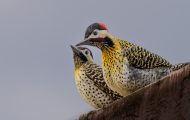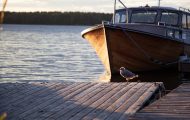Are you looking for ways to keep birds away from your backyard pond? You’re not alone.
Having a fish pond in your backyard can be both beautiful and peaceful. However, sometimes birds can appear unwelcome – landing on the water or eating your fish! If you are considering keeping a fish pond, it is important to take a few steps to ensure that birds stay away. There are some simple methods to keep birds away from your pond so that you can enjoy the tranquility of your aquatic oasis.
In this article, we’ll discuss how to keep birds away from your fish pond so that both humans and animals can enjoy it safely and peacefully!
10 Pond Birds
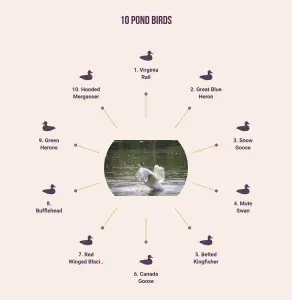 Some birds are more likely to be drawn to your pond than others. Knowing which species you may see can help you identify them and provide proper deterrents. Here are 10 of the most common birds that may visit your pond:
Some birds are more likely to be drawn to your pond than others. Knowing which species you may see can help you identify them and provide proper deterrents. Here are 10 of the most common birds that may visit your pond:
1. Virginia Rail
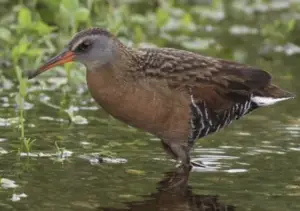 Virginia Rail is a pond bird species found in marshes, swamps, and other wetland habitats throughout the United States. These slender rails have long toes that help them traverse through thick vegetation and narrow spaces underwater.
Virginia Rail is a pond bird species found in marshes, swamps, and other wetland habitats throughout the United States. These slender rails have long toes that help them traverse through thick vegetation and narrow spaces underwater.
During migration season, the Virginia Rail is often seen in low-lying areas along lakeshores and near road edges. They feed mainly on small aquatic invertebrates like insects, crustaceans, spiders, and their larvae. During the breeding season, they are territorial, defending their nest site from intruders while they strive to incubate eggs and raise their young.
While active throughout the year, these birds favor denser cover during winter months, when they seek to protect themselves from harsh weather. During this period of cold temperatures, Virginia Rails often display an incredibly loud call for mates or establish territorial boundaries. This sound can be heard for up to half a mile!
2. Great Blue Heron
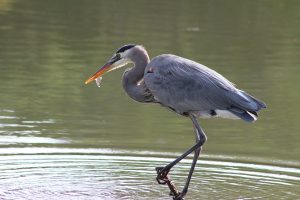 The Great Blue Heron is an iconic pond bird seen throughout North America. Standing tall at nearly four feet and with a six-foot wingspan, this impressive heron is easily recognizable for its slate-colored body, white throat, and unique crest above the eyes.
The Great Blue Heron is an iconic pond bird seen throughout North America. Standing tall at nearly four feet and with a six-foot wingspan, this impressive heron is easily recognizable for its slate-colored body, white throat, and unique crest above the eyes.
If you’re lucky enough to come across one of these majestic birds near a pond or lake, you’ll likely also spot them perched on some kind of perch near the water’s edge and waiting for their prey. Although they primarily feed on small fish, frogs, snakes, and other amphibians, the Great Blue Heron is also known to dine upon larger meals like crayfish, aquatic insects, and even small mammals!
3. Snow Goose
 The snow goose is easily recognized for its all-white body and black wingtips. Snow geese are a large species of birds that flock in groups across the North American continent. If you’re lucky enough to find them on one of their migration trips, you can witness spectacular group movements from afar. Interestingly, snow geese fly in unique V-shaped formations with each other when migrating for greater ease and stability during the journey.
The snow goose is easily recognized for its all-white body and black wingtips. Snow geese are a large species of birds that flock in groups across the North American continent. If you’re lucky enough to find them on one of their migration trips, you can witness spectacular group movements from afar. Interestingly, snow geese fly in unique V-shaped formations with each other when migrating for greater ease and stability during the journey.
These beautiful birds make several different calls: ‘honking,’ ‘cooing,’ and ‘cackling.’ Despite multiple predators, such as foxes, raccoons, coyotes, and even bald eagles, they have managed to stay around year after year. They also feed heavily on the land, making them adapt quite well to wetland habitats like ponds throughout their journey.
4. Mute Swan
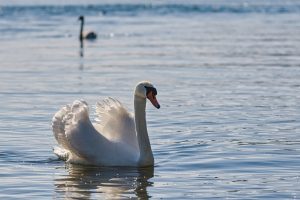 The Mute Swan is a beautiful bird species that can be found in many ponds around the world. This large white swan is easily identifiable by its bright orange bill and snow-white feathers with a black knob at the end of its long neck. They are also known for their gracefully curved neck when they glide through the water.
The Mute Swan is a beautiful bird species that can be found in many ponds around the world. This large white swan is easily identifiable by its bright orange bill and snow-white feathers with a black knob at the end of its long neck. They are also known for their gracefully curved neck when they glide through the water.
Mute Swans are generally peaceful birds, though, during mating season, they can become aggressive and territorial when protecting the nest areas for their eggs. In addition to the appearance of this species, certain behaviors should be noted.
When feeding, Mute Swans often float along with their wings extended out from their bodies, but unlike other pond bird species, they do not move their webbed feet or glide on the water’s surface for propulsion. As such, they rely on wind gusts to propel them forward when traveling.
5. Belted Kingfisher
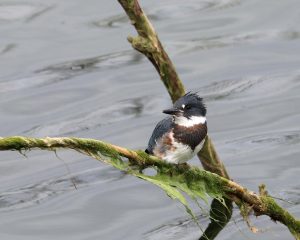 The Belted Kingfisher is one of the most distinct and beautiful birds found in ponds. Unsurprisingly, this is often the first bird visitors are drawn to when looking around a pond, with bright, vibrant blues, easy-to-identify stripes, and its trademark crest atop its head. Often sitting upon a low perch, the Belted Kingfisher seems content to watch over their domain as they wait for something prey worthy of swimming by.
The Belted Kingfisher is one of the most distinct and beautiful birds found in ponds. Unsurprisingly, this is often the first bird visitors are drawn to when looking around a pond, with bright, vibrant blues, easy-to-identify stripes, and its trademark crest atop its head. Often sitting upon a low perch, the Belted Kingfisher seems content to watch over their domain as they wait for something prey worthy of swimming by.
Once they spot something, they dive with amazing speed and agility, snagging a meal before returning to their perch. Not only do they feed on small fish but also insects, crustaceans, reptiles, amphibians, and other assorted aquatic life. Belted Kingfishers usually nest in trees beside or overhanging water sources.
Still, they occasionally will create burrows along river banks or lakeshores if there are no suitable trees nearby for them to use. They were once considered uncommon. However, recent reports have shown increases in their numbers across North America, so be sure to keep an eye out for them next time you’re near any body of water!
6. Canada Goose
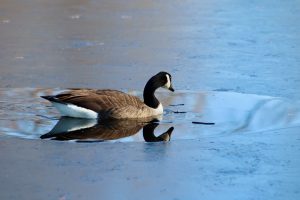 Canada Geese are some of the most abundant yet fascinating birds that call North America’s ponds and waterways home. These geese make an unforgettable spectacle wherever they go with striking black-and-white plumage and impressive wingspans up to five feet.
Canada Geese are some of the most abundant yet fascinating birds that call North America’s ponds and waterways home. These geese make an unforgettable spectacle wherever they go with striking black-and-white plumage and impressive wingspans up to five feet.
Though often viewed as a nuisance in urban areas, these magnificent waterfowl play a vital role in their local ecosystems, providing food for predators when they migrate and controlling overgrown aquatic vegetation by consuming it. Canada Geese also offer people plenty of recreational activities, such as birdwatching and hunting, allowing us to connect with nature in ways we couldn’t live without them.
Conservation efforts have helped this species recover from near-extinction several decades ago to now being quite thriving across the continent!
7. Red Winged Blackbird
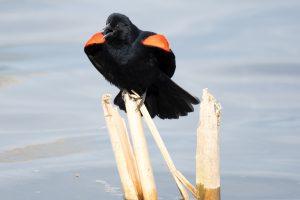 The red-winged blackbird is a species of bird that can usually be found living around ponds, marshes, and wetlands. This small but fascinating species is one of the most familiar birds in North America and can be easily recognized by its rich black body and red-and-yellow shoulder shield.
The red-winged blackbird is a species of bird that can usually be found living around ponds, marshes, and wetlands. This small but fascinating species is one of the most familiar birds in North America and can be easily recognized by its rich black body and red-and-yellow shoulder shield.
The male red-winged blackbird is especially distinctive in its appearance due to its bright colors, while the female has more subdued brown tones. In addition to its attractive coloration, the red-winged blackbird also has a distinctive call – what some might describe as a ‘charming trill’ – which it uses to attract mates and establish territory.
In their natural habitats, these birds feed on insects such as earthworms, beetle larvae, and many types of aquatic invertebrates, although they have been known to eat fruit and other plant matter too. During summer months, you may also be lucky enough to spot a family of red-winged blackbirds nesting near water bodies like ponds or lakes.
8. Bufflehead
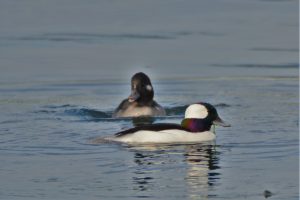 The Bufflehead is a species of aquatic bird found mostly in ponds and rivers. Its black-and-white feathers and quirky silhouette has earned it the nickname “Butterball” for its roundish figure. Buffleheads are vigorous divers and highly maneuverable when in flight. They consume small insects, crustaceans, fish, and mollusks caught both underwater and on the pond’s surface.
The Bufflehead is a species of aquatic bird found mostly in ponds and rivers. Its black-and-white feathers and quirky silhouette has earned it the nickname “Butterball” for its roundish figure. Buffleheads are vigorous divers and highly maneuverable when in flight. They consume small insects, crustaceans, fish, and mollusks caught both underwater and on the pond’s surface.
Besides the distinctive shape, these birds are also recognized by their loud calls, which can be heard echoing across the waterway. Bufflehead pairs build their nests out at sea, often near submerged logs. In colder climates, though, some pairs may opt for more isolated inland ponds for nesting as well.
9. Green Herons
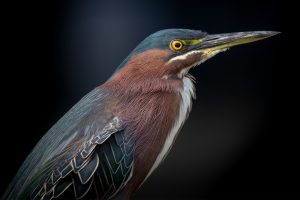 The Green Heron, or Butorides virescens, is one of the fascinating pond bird species out there. From the neck up, they have a light greenish-gray head with a long pointed bill and a brown eye line above their black eyes. This species also has an impressive olive-brown coat that has given it its name.
The Green Heron, or Butorides virescens, is one of the fascinating pond bird species out there. From the neck up, they have a light greenish-gray head with a long pointed bill and a brown eye line above their black eyes. This species also has an impressive olive-brown coat that has given it its name.
In breeding season, you will find these birds building glossy cup-shaped nests in trees near water sources or even on the ground if they can find space. And when they hunt for fish, this species uses various techniques – dropping bait in the water to lure prey closer, standing still as if waiting patiently for a fish to take hold of something planted by them! Even more interesting is that these birds can then grab their prey using one foot instead of two.
10. Hooded Merganser
 These ducks have an impressive tuft of feathers on the top of their heads that resemble a hood, hence their name. Male Hooded Mergansers are striking in appearance, typically boasting a handsome black and white plumage paired with a deep chestnut neck. Females are more drably colored but just as breathtaking in their own subtle way.
These ducks have an impressive tuft of feathers on the top of their heads that resemble a hood, hence their name. Male Hooded Mergansers are striking in appearance, typically boasting a handsome black and white plumage paired with a deep chestnut neck. Females are more drably colored but just as breathtaking in their own subtle way.
This elegant species’ most peculiar physical trait is its sharply pointed bill, which is both sharp-looking and surprisingly useful in helping the birds to catch small fish from ponds. What’s more, Hooded Mergansers have adapted special adaptations that make them well-equipped for a life spent mostly on the water. They have powerful legs that can easily propel them through the water and webbed feet for improved maneuverability in creeks and marshes.
How To Keep Birds Away From Fish Pond
Having birds at your fish pond can be a source of joy, but it can also be problematic for the fish and other creatures in the water. To discourage birds from visiting your pond regularly, you can take several steps. Here are a few tips on how to keep birds away from your fish pond:
Animal Decoys
Just like those rubber snakes or plastic owls that you see in nurseries, decoys can be your best bet to keep those pesky birds from invading your fish pond.
First on the list is the good old scarecrow. Traditional and effective scarecrows have been used for years by farmers to keep birds away from their crops. This method can work for fish ponds as well.
Place a scarecrow near your pond, and birds will think twice before approaching it. Even better, make the scarecrow look like a predator of the birds, such as an eagle or hawk. This will make the birds want to avoid your pond at all costs.
Second, on the list is the plastic alligator. Okay, this one may sound a bit weird, but it can be a great way to keep birds away from your fish pond. Simply place a plastic alligator (or crocodile) in your pond, and birds will think twice before dipping. This method can be especially effective for herons and other wading birds. They’ll see the alligator and think it’s real, so they’ll turn around and find a new place to hunt for food.
Lastly, the owl decoy. Owls are natural predators of many birds, so placing an owl decoy near your pond can be a great way to keep the birds away. Place the heron decoy in a visible location, such as on a rock or near a tree, to make it seem more realistic. You can even get a decoy with moving parts, such as a head that swivels in the wind, to make it even more lifelike.
Bird Feeder
Feeders are a fantastic way to distract birds from your fish pond. By providing birds with an alternative food source, they will be less likely to go after your fish. Plus, bird feeders can also attract birds that don’t typically eat fish, which can enhance your backyard bird-watching experience.
One type of bird feeder that is particularly effective at keeping birds away from fish ponds is the platform feeder. These flat feeders have no sides, making it difficult for birds to perch and stay for extended periods. Simply place the feeder near the pond and fill it with birdseed. The birds will flock to the feeder, leaving your fish alone.
Another type of feeder to consider is the suet feeder. Suet is a high-fat food that is especially appealing to woodpeckers, nuthatches, and other birds that typically eat insects. You can attract these birds to your backyard by offering suet and keeping them from going after your fish.
When selecting a bird feeder for your backyard, it’s important to choose one that is sturdy and easy to maintain. Look for feeders that are made from durable materials and have removable parts for easy cleaning. Additionally, keep your feeder well-stocked with food to keep birds coming back for more.
Create a Hiding Place
First, you need to install aquatic plants like water lilies, floating ferns, or water hyacinths in your pond. These plants provide a lot of benefits to your fish, like oxygen supply and habitat for algae or other small organisms. They also give fish an excellent place to hide from birds.
Apart from the plants, you can create a fish cave or shelter by submerging rocks or clay pots in different pond parts. These structures serve as hiding places for your fish and add beauty and character to your pond. You can also create fish shelters by using natural materials like driftwood or rocks to form underwater nooks and crannies.
When considering a hiding place, note that you want to make it simple enough. If it’s too complex, it could become impossible to catch your fish when you need them for health or other purposes. You want to create hiding places that somewhat simplify the life of fish but also make it hard for predators.
Pond Netting
Netting is the most common and efficient technique for keeping birds away from your fish ponds. It is a physical barrier that covers your entire pond and keeps birds from accessing it. But how do you install netting?
Firstly, measure the size of your pond and get a slightly bigger netting. This will ensure that the netting covers the entire pond, making it hard for intruding birds.
Next, fix the pond net with a few essentials like support poles, stakes, and weights. Ensure that it’s suspended a few inches above the water. This guarantees that the birds do not get tangled in the netting while trying to access the pond.
Additionally, this is not a one-time job; you must frequently check the pond net for any tears or holes. This is because birds will still manage to access the pond and cause damage if there is a hole. Also, ensure that there aren’t any birds trapped in the netting, which can hurt them.
Lastly, keep in mind that cleanliness is essential. Ensure that you remove any debris or food leftovers from around the pond. This eliminates any reason for birds to be drawn to the pond.
Pinwheels
When the wind blows, the pinwheels spin around, and the movement and reflection from the shiny surfaces scare birds away. Birds get scared easily, and the spinning pinwheels provide enough movement and noise to keep them at bay.
To create your pinwheels, you just need a few supplies readily available at your local crafts store. You will need some colorful craft paper, scissors, wooden dowels, beads, and glue.
Cut the craft paper in the desired shape of your pinwheel, place the beads in the center of the pinwheel, then attach the pinwheel to the dowel with glue. You can make as many pinwheels as you like and place them around your pond.
Not only are pinwheels an effective way to keep birds away from your fish pond, but they are also a beautiful addition to your garden décor. They come in various colors and patterns, so you can choose those that match your garden’s vibe.
Balloons
Birds are naturally afraid of balloons. The movement and noise they make in the wind warn birds that potential danger is nearby. Placing balloons around your fish pond can create an invisible barrier that keeps birds from attacking your beloved fish.
But before you start filling up balloons, there are some things you need to know to make sure this technique is effective.
Firstly, choose the right type of balloons. To scare away birds, you need brightly colored, reflective balloons with an iridescent or metallic surface. These balloons reflect the sunlight and create a flashing effect, further intimidating the birds.
Next, determine the placement of the balloons. Try to create a perimeter around the pond by placing the balloons on high poles or around the pond’s perimeter. This will create a visible barrier that birds will be less likely to cross.
Finally, keep the balloons inflated and regularly move them around. Balloons lose their effectiveness if they remain in the same spot for too long. Changing their position and inflating them will keep the birds guessing and ultimately away from your fish.
Motion Activated Sprinkler
The motion-activated sprinkler has a sensor that can detect any movement within its range. It responds by releasing a strong burst of water, effectively scaring away the birds.
To get started, you’ll need to purchase a motion-activated sprinkler. Several options are available in the market, ranging from budget-friendly to high-end models. You can choose the one that suits your requirement.
The next step is to set up the sprinkler around your pond. You can position it strategically but ensure it covers the entire pond perimeter. Once you’ve placed the sprinkler, connect it to a water source and switch it on.
You might have to adjust the sensitivity level of the sensor depending on the size of your pond and the number of birds in your area. But once that’s done, sit back and relax while the sprinkler does its job.
Noise and Lights
The sound of a predator can give birds the impression that there’s danger near your fish pond. You can play bird distress calls on a speaker near your pond to give birds a warning call. They will believe that a potential predator is lurking around, causing them to stay away.
Another way to reduce the likelihood of birds visiting your pond is by using light. Birds are diurnal creatures that prefer feeding during daylight hours. If you use the right lighting system, such as motion-activated lights, it can throw them off their feeding schedule, causing them to avoid your pond.
Dogs
If you’re an avid dog lover and have a beautiful fish pond in your yard, you may have encountered a pesky problem of birds trying to swoop in for a quick meal. Nobody wants to see their beloved pets going after those expensive koi pond fish, and you certainly don’t want to scare off the birds by constantly yelling at your dog.
Make sure your dog is well-trained. If your pooch has been properly socialized with birds, they are less likely to treat them as prey. If you’ve adopted a dog who has not been socialized, you can work with a professional dog trainer or behaviorist to help them learn appropriate behavior around birds.
Garlic, Cayenne, and Peppermint Oil
Garlic, cayenne, and peppermint oils are some of the most effective natural bird repellents available. These ingredients have a strong odor that birds don’t like and will avoid when they detect it.
To use these solutions, you can either spray them directly onto the water surface or add them to the fish food. The oils will mix with the water and create a strong scent, which birds will detect and avoid coming near the pond.
You can also add these ingredients to your homemade bird-repellent recipes or purchase ready-made solutions from the store. Whatever option you choose, use only natural solutions without any artificial additives, as they may be harmful to your fish.
Frequently Asked Questions
Q: Do pigeons eat fish from ponds?
Pigeons are not fish-eaters by nature, but they will occasionally visit a pond to see what food sources are available. Generally, the only type of fish eaten by pigeons is dead or frozen, as it’s hard for them to catch them alive. Pigeons tend to rely on other types of food, such as grains and seeds.
Q: Does using fishing line to protect pond fish work?
A fishing line can be used as a deterrent to keep birds away from your pond, but it’s generally not a good option. Fishing lines can easily get tangled and create an unsafe environment for the fish. It also needs to be monitored regularly and loses effectiveness over time.
Q: How to keep a heron out of your pond?
One preventative measure is to install a “scare cable” – a type of wire that, when brushed up against, alerts the bird with an electric signal and encourages them to fly away. Consider investing in a static propagation system, which emits strong air pulses to scare birds away. Strategically placing netting around the edges of your pond or over the entire surface can also help keep curious herons from visiting. It’s important to ensure any netting you use is specifically designed for keeping birds out and properly secured so your birds won’t get tangled.
Q: Why do birds flock to my pond?
Birds are attracted to ponds because they contain a variety of food sources. Insects, small fish, and amphibians all live in and around the water, making it an ideal spot for birds to hunt and feed. Additionally, shallow waters provide a great place for birds to bathe or drink, which can also be a draw.
Q: Are there any other ways I can protect my fish?
Yes! One way to protect your fish is to install a pond cover. A pond cover acts as a shield from predators and can also help keep debris out of the water. Additionally, you can add plants around the pond’s perimeter, which act as a natural barrier for birds and other animals.
Conclusion
Keeping a flock of birds away from your fish pond can be tricky but is certainly doable. You can ensure your watery friends stay safe from unwanted predators with the right strategies and natural bird repellents. Try out different methods and find what works best for your unique situation.

